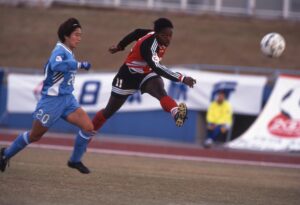“History of the Nadeshiko League” 6. “The Boom Years”
From the time when it was still unusual for women to play football, through to the birth of the Japan Women’s Football League, victory in the Women’s World Cup, and creation of the Japan Women’s Empowerment Professional Football League, social conditions and the environment surrounding girls’ and women’s football have undergone great changes.
We intend to publish a series of 22 articles before the end of the year in which we will look back over the tempestuous history of girls’ and women’s football in Japan.

From the second to the fourth seasons of the Japan Women’s Football League (the current Nadeshiko League) between 1990 and 1993, Yomiuri Beleza were champions for three years running, going a record 51 games without defeat. During this period, conditions surrounding football in Japan underwent major changes with the birth of the J.League.
J.League games officially started in 1993. However, noises about Japan finally having its own professional football league started to be heard in the media from around 1990. In 1992, when the first official games were held in the Nabisco Cup and the Japan national team made major progress (winning the Asia Cup), interest in football exploded throughout Japan.
As numerous corporations became interested in football, a number of companies decided to form their own women’s football teams. One such company was Nikko Securities. Under the initiative of company president Mr. Takuya Iwasaki, who was also an avid football fan, “Nikko Securities Dream Ladies” was formed in Chiba Prefecture in 1990. With Ryohei Suzuki, former manager of the Japan women’s national football team, as manager, the team assembled outstanding players and quickly became a powerhouse. In March 1991, at the end of the team’s maiden season, Nikko Securities Dream Ladies won the Empress’s Cup JFA Japan Women’s Football Championship. This victory, achieved after winning through on penalties against Beleza in the quarter finals and Suzuyo Shimizu Lovely Ladies in the final, was a great surprise to those concerned.
In its third season (1991), the Japan Women’s Football League was contested by 10 teams following the addition of four newcomers: Nikko Securities, Asahi Kokusai Bunnys Ladies SC (Osaka), Matsushita Electric Industrial Ladies SC Bambina (Osaka), and Fujita Tendai Soccer Club Mercury (Kanagawa).
Women’s football still faced difficulties around the world in the early 1990s. The 1st FIFA Women’s World Cup was held in China in 1991 and won by the United States with an overwhelming show of strength, however, even the United States did not have a national league and players on the US national team had to practice individually while working as coaches at their alma mater. Countries in Europe had clubs and national leagues, however, the women’s game was badly underfunded.
Despite being amateur, the Japan Women’s Football League was regarded as the most “affluent league” in the world at that time because players were guaranteed employment and provided with a good training environment by large companies. As a result, Japanese clubs attracted a succession of the world’s best players. A contributory factor to this was the strong impression imparted by the Chinese Taipei forward Chou Tai-ying, who was the top scorer and led Shimizu FC to the title in the league’s first season.
The “rush of overseas players” started in the third season of the league in 1991 and steadily escalated after that. In 1992, Nikko Securities caused a stir when it announced the addition of the Norwegian forward Linda Medalen and defender Gunn Nyborg. Both players were regular members of the Norway women’s national football team that had finished as runners-up at the FIFA Women’s World Cup in the previous year. In particular, Medalen was an international star who had finished third in the scoring rankings and was also voted the third most valuable player in the World Cup. In her first season in Japan, she finished with 17 goals and became the league’s leading scorer. In 1994, when the league was in its sixth year, Prima Ham FC Kunoichi’s forward Charmaine Hooper, a member of the Canada women’s national football team, was top scorer after recording a phenomenal 24 goals in 18 games.
The Japan Women’s Football League was carried along in the slipstream of the J.League, which experienced a boom from 1993 to 1994. In September 1994, the league announced its new name of “L. League”, which was used until it became the “Nadeshiko League” in 2004.
Soon after, the league announced its official theme song “OH OH OH – We are the Winners”. With popular idol Noriko Sakai singing the main vocals and one player from each of the 10 clubs forming the chorus, the song was released in February 1995.
Following the release of this official theme song, the respective clubs released their own songs performed by popular singers and celebrities of the day. Examples included the Beleza song performed by Akiko Wada, the Nikko Securities song performed by Yu Hayami, and the TOKYO SHIDAX LSC (renamed from Shinko Seiko FC Clair in 1993) song performed by Marusia. Such developments caused quite a stir.
However, it wasn’t all plain sailing. The decision to disband Nissan FC Ladies was made at the end of 1993. Extinction of this team, the successor to FC Jinnan, which had been a pioneer of women’s football in Tokyo and had won the first Empress’s Cup in 1979, foreshadowed difficult times ahead for the L-League.
Yoshiyuki Osumi (football journalist)






